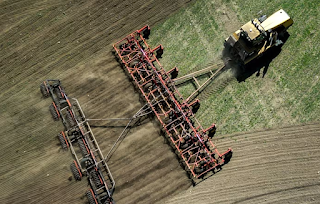Unearthing the Reality of Regenerative Agriculture: Balancing Act or Greenwashing?
In the rolling hills of Chard, Somerset, Tom Gregory sips tea in his farmhouse, contemplating the enigma of soil health. A decade into organic dairy farming, the earth spoke a truth – their efforts fell short. Enter regenerative agriculture, a global trend gaining traction among farmers, backed by big names like Arla and major food companies.
🌱 The Green Promise: Regenerative agriculture promises improved soil quality, enhanced crop yields, and carbon sequestration. As major corporations, including Nestlé and Danone, pledge billions towards converting vast land areas, the agricultural landscape is shifting. But, does the green promise hold up under scrutiny?
🌍 The Carbon Conundrum: While regenerative practices offer multiple benefits, skeptics question its role in solving the agri-food sector's emissions dilemma. Carbon sequestration in soils becomes a focal point. Can soil truly absorb and store carbon as effectively as proponents claim? The debate rages on, echoing the skepticism surrounding nature-based carbon offset markets.
🌾 Defining the Landscape: Regenerative agriculture, primarily about regenerating soil, involves reduced pesticide use, cover crops, and no-till practices. Yet, amidst the buzz, the industry lacks a standardized definition and clear targets, challenging claims and progress.
💡 The Tech Challenge: Accurately measuring soil carbon sequestration poses a hurdle. While the technology exists, it's costly. For farmers and food companies, the expense often outweighs the value of the carbon, leading to reliance on computer models.
💰 Investment Dilemma: Major players like Nestlé and PepsiCo invest substantial sums in regenerative agriculture. However, the lack of clear targets and definitions raises concerns, prompting questions about greenwashing and the true impact of these investments.
🔄 The Bottom Line: Regenerative agriculture makes environmental sense, promoting soil health, water retention, and resilient crops. However, the carbon aspect raises eyebrows. As the debate continues, the industry faces a crucial balancing act between promising green solutions and the need for tangible, measurable impact.
🔗 Join the Conversation: What's your take on the regenerative agriculture phenomenon? Share your thoughts below! 🌾🌍
FAQ Addendum: Q: What is regenerative agriculture, and why are food companies investing in it? A: Regenerative agriculture focuses on improving soil health through practices like reduced tilling, diverse pasture planting, and cover crops. Food companies are investing in it for increased crop yields, reduced environmental impact, and carbon sequestration.
Q: Are there concerns about the effectiveness of soil carbon sequestration in offsetting emissions? A: Yes, skeptics argue that the carbon sequestration potential of soil may be overstated, and there are challenges in accurately measuring and achieving meaningful offsets.
#RegenAgDebate, #GreenSolutions, #AgricultureRevolution, #CarbonConundrum, #SustainableFarming

